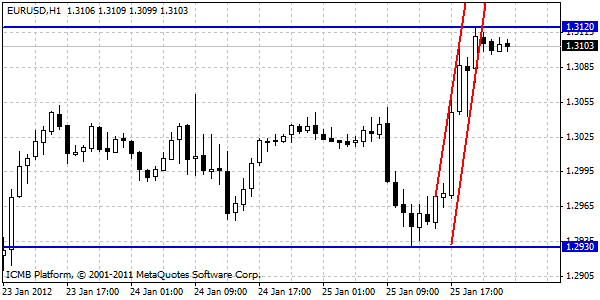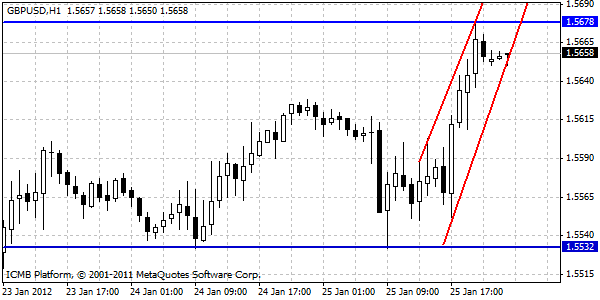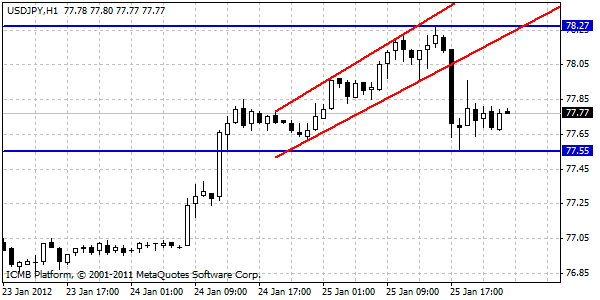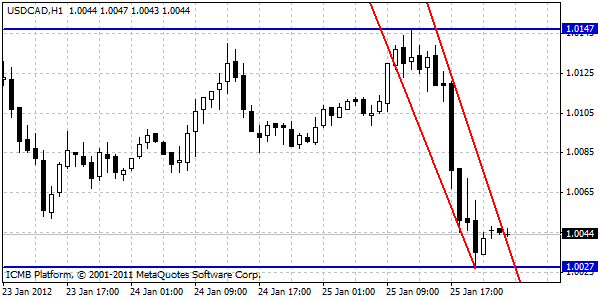The euro rallied after the Federal Reserve decided to extend its pledge to hold its target for the federal funds rate low until late 2014 amid a highly accommodative monetary policy. Economic conditions including low rates of resource utilization and a subdued outlook for inflation over the medium run are likely to warrant exceptionally low levels for the federal funds rate at least through late 2014. The first projections by FOMC participants released in Washington provide an unprecedented look at policy makers’ plans for the path of the benchmark interest rate which has remained near zero since December 2008. An increase in 2014 would mark the first rise in the fed funds rate since June 2006. Together with this projection, policy makers also lowered their estimates for growth and inflation in 2012. Moreover, Fed Chairman Ben S. Bernanke said that the option of further large-scale bond purchases is still on the table. As a result of this remarkable announcement, euro gained 0.6% against the dollar to $1.3112 and reached $ 1.3121 erasing the earlier declined when European Central Bank said to oppose restructuring its Greek bonds. EUR/USD" title="EUR/USD" width="841" height="752">
EUR/USD" title="EUR/USD" width="841" height="752">
GBP/USD
The pound fell 0.3 percent to $1.5580 after a report showed U.K. gross domestic product contracted 0.2 percent from the third quarter compared with a drop of 0.1 percent economists anticipated. U.K. manufacturers' sentiment deteriorated over the last three months, dampened by falling demand and stagnant output. The order book balance came in at -16 percent in January better-than the -19 percent forecast. During three months ended January, 27 percent of respondents reported an increase in output, while 26 percent registered decline. The resulting positive balance of 2 percent showed that production weakened sharply in the three months to January. CBI Chief Economic Adviser Ian McCafferty said while the severe fears seen at the end of last year over global demand may be subsiding, 2012 will prove to be a difficult year for UK manufacturing as the crisis in the Eurozone; biggest export market has yet to reach any definitive resolution. However, the declines in sterling were limited after England Governor Mervyn King said that policy makers can increase stimulus again if needed to guard against a renewed severe downturn. Policymakers of the Bank of England were unanimous on this month's decision to maintain the asset purchase level at GBP 275 billion and the key interest rate at a historic low, minutes of the rate-setting session revealed. The central bank decided to leave the key interest rate unchanged at 0.50 percent and to continue the quantitative easing at the current level of GBP 275 billion on January 12. The bank is widely expected to expand its asset purchases next month when the current expansion ends.  GBP/USD" title="GBP/USD" width="841" height="752">
GBP/USD" title="GBP/USD" width="841" height="752">
USD/JPY
The yen fell against most its major counterparts after the Ministry of Finance said Japan’s exports dropped 8 percent in December from a year earlier. The Bank of Japan said that the country's exports are likely to increase moderately going forward as recovery in overseas economies gathers pace. Exports and production have remained more or less flat due to the slowdown in overseas economies and the yen's appreciation as well as the remaining effects of the flooding in Thailand. As a result, Japan posted its first annual trade deficit since 1980 with a shortfall of JPY 2.49 trillion in 2011. This largely reflected the fallout from Japan's worst earthquake on record in March which sparked a nuclear crisis that shut most reactors, as well as longer-term shifts such as Nissan Motor Co.’s decision to move some production to lower-cost Thailand. The government needs to put back momentum here however, till this time they haven’t found right solution to electricity and no clear when they can have nuclear power back again. With the population declining since 2006 and a Cabinet Office reported indicating a trend rate of economic growth of 1 percent in coming years, policy makers are under pressure to take steps that avert a crisis of confidence in the nation’s debt. The finance ministry said total outstanding borrowing will probably reach 985.4 trillion yen in the year ending March 2012 up 6.6 percent from a year earlier. Prime Minister Yoshihiko Noda reiterated his call for opposition lawmakers to engage in talks on boosting the sales levy. The ruling Democratic Party of Japan wants parliamentary approval to raise the tax to 8 percent in April 2014 and then to 10 percent in October 2015 from 5 percent now. USD/JPY" title="USD/JPY" width="841" height="752">
USD/JPY" title="USD/JPY" width="841" height="752">
USD/CAD
Canada’s dollar gained to the strongest in almost three months after U.S. policy makers said their key interest rate will stay at almost zero until at least late 2014, boosting the attraction of Canada’s 1 percent rate. The Federal Open Market Committee has kept its benchmark rate at a range of zero to 0.25 percent since December 2008 in an effort to support the economy. Inflation remains tame and more than two years of economic growth have failed to push unemployment below 8.5 percent. The currency fell earlier as speculation that Europe may be unable to contain its sovereign-debt crisis damped demand for riskier assets. Meanwhile, Canadian government bonds rose, pushing benchmark 10-year note yields down four basis points, or 0.04 percentage point, to 2.04 percent. It was the yields’ first decline in six days. The price of the 3.25 percent securities maturing in June 2021 increased 35 cents to C$110.21. Canada sold C$3 billion ($2.96 billion) of three-year notes. The 1 percent securities mature in February 2015. USD/CAD" title="USD/CAD" width="841" height="752">
USD/CAD" title="USD/CAD" width="841" height="752">
- English (UK)
- English (India)
- English (Canada)
- English (Australia)
- English (South Africa)
- English (Philippines)
- English (Nigeria)
- Deutsch
- Español (España)
- Español (México)
- Français
- Italiano
- Nederlands
- Português (Portugal)
- Polski
- Português (Brasil)
- Русский
- Türkçe
- العربية
- Ελληνικά
- Svenska
- Suomi
- עברית
- 日本語
- 한국어
- 简体中文
- 繁體中文
- Bahasa Indonesia
- Bahasa Melayu
- ไทย
- Tiếng Việt
- हिंदी
Technical Analysis: EUR/USD, GBP/USD, USD/JPY, and USD/CAD
Published 01/26/2012, 08:20 AM
Updated 04/25/2018, 04:40 AM
Technical Analysis: EUR/USD, GBP/USD, USD/JPY, and USD/CAD
EUR/USD
Latest comments
Loading next article…
Install Our App
Risk Disclosure: Trading in financial instruments and/or cryptocurrencies involves high risks including the risk of losing some, or all, of your investment amount, and may not be suitable for all investors. Prices of cryptocurrencies are extremely volatile and may be affected by external factors such as financial, regulatory or political events. Trading on margin increases the financial risks.
Before deciding to trade in financial instrument or cryptocurrencies you should be fully informed of the risks and costs associated with trading the financial markets, carefully consider your investment objectives, level of experience, and risk appetite, and seek professional advice where needed.
Fusion Media would like to remind you that the data contained in this website is not necessarily real-time nor accurate. The data and prices on the website are not necessarily provided by any market or exchange, but may be provided by market makers, and so prices may not be accurate and may differ from the actual price at any given market, meaning prices are indicative and not appropriate for trading purposes. Fusion Media and any provider of the data contained in this website will not accept liability for any loss or damage as a result of your trading, or your reliance on the information contained within this website.
It is prohibited to use, store, reproduce, display, modify, transmit or distribute the data contained in this website without the explicit prior written permission of Fusion Media and/or the data provider. All intellectual property rights are reserved by the providers and/or the exchange providing the data contained in this website.
Fusion Media may be compensated by the advertisers that appear on the website, based on your interaction with the advertisements or advertisers.
Before deciding to trade in financial instrument or cryptocurrencies you should be fully informed of the risks and costs associated with trading the financial markets, carefully consider your investment objectives, level of experience, and risk appetite, and seek professional advice where needed.
Fusion Media would like to remind you that the data contained in this website is not necessarily real-time nor accurate. The data and prices on the website are not necessarily provided by any market or exchange, but may be provided by market makers, and so prices may not be accurate and may differ from the actual price at any given market, meaning prices are indicative and not appropriate for trading purposes. Fusion Media and any provider of the data contained in this website will not accept liability for any loss or damage as a result of your trading, or your reliance on the information contained within this website.
It is prohibited to use, store, reproduce, display, modify, transmit or distribute the data contained in this website without the explicit prior written permission of Fusion Media and/or the data provider. All intellectual property rights are reserved by the providers and/or the exchange providing the data contained in this website.
Fusion Media may be compensated by the advertisers that appear on the website, based on your interaction with the advertisements or advertisers.
© 2007-2025 - Fusion Media Limited. All Rights Reserved.
